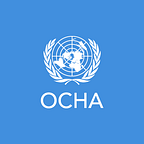Five ways humanitarians use technological innovation to deliver during COVID-19
Humanitarian needs are already at their highest level in decades, but COVID-19 is causing them to soar further. The World Food Programme (WFP) estimates that 265 million people could be pushed to the brink of starvation by year’s end. In response, humanitarian agencies are stepping up and finding innovative ways to overcome unprecedented access barriers. Here are five ways we are adopting technological solutions to identify and track needs, reach at-risk populations from afar, fill health supply gaps, teach children and provide information to communities on how to stay safe.
Remote technologies to deliver aid
Drones, blockchain and 3D printing are some of the tools for humanitarian agencies to deliver from afar to overcome travel restrictions and risks of inadvertently spreading COVID19. In Cameroon the Office for the Coordination of Humanitarian Affairs, or OCHA, is collaborating with the Ministry of Health, engineering school Polytechnique and the Israeli Embassy to support 3D printing of masks and respirators for health workers and facilities. Elsewhere, drones are being used by companies, governments, humanitarian organizations and others to deliver assistance and medical support. For example, Zipline uses drones to deliver medical products in Rwanda and to bring testing samples to labs in Ghana. The drones work this way: a health worker sends a text to order a supply, a drone then picks it up and delivers it from a distribution centre. It can carry up to 1.8 kg of cargo and travel 90 miles an hour. Blockchain technology is also being used to allow multiple partners to remotely provide and track the flows of cash assistance.
Maps, modelling and missing data
Many aid agencies are harnessing data to generate real-time interactive maps for situational awareness. These include the World Health Organization’s (WHO) real-time COVID-19 caseload dashboard; the Humanitarian Data Exchange’s COVID-19 pandemic dashboard tracking cases in 25 countries; WFP’s hunger map, which predicts hunger in real time; and its school-feeding map to show the impact of school closures on hunger. Satellite imagery is also being layered with vulnerability data to identify high-risk areas. In Yemen, analysts integrate data on COVID-19 cases, internally displaced people, food insecurity and malnutrition levels with spatial data to create vulnerability maps. And in Somalia, which has high numbers of displaced people, maps track border crossings, access roads, emergency hubs and hospitals.
Anticipating and modelling risk
The COVID-19 pandemic has brought into stark focus the need for data and the value of models to anticipate and model future risks. Because of this, OCHA’s Centre for Humanitarian Data is partnering with The Rockefeller Foundation to increase the use of predictive analytics to drive anticipatory action. They have created a model to estimate the scale, severity and duration of the COVID-19 outbreak in priority countries including Afghanistan, the Democratic Republic of the Congo, Sudan, and South Sudan. Multiple agencies feed into the INFORM risk tool, which analyses a country’s health-related risks (including COVID-19) and humanitarian crises, combined with its national capacity to cope. According to INFORM’s findings, sub-Saharan Africa contains seven of the world’s ten countries with highest overall risk. Humanitarian organizations are increasingly using predictive analytics to map anticipated vulnerability and need, but these models can only work based on good data. For example, the Centre for Humanitarian Data has struggled to find sub-national or gender-disaggregated data on co-morbidities such as tuberculosis and HIV/AIDS, as well as good access mobility data. Instead, it resorted to using road density data as a proxy. UN Women meanwhile, is on a mission to disaggregate COVID-19 data by gender.
Blockchain and mobile money solutions
The impact of the global recession triggered by COVID-19 could dwarf the impacts of the virus itself. OCHA estimates US$90 billion will be needed to help the most vulnerable people survive. One of the fastest and most effective way is through cash assistance, as it puts money into the hands of beneficiaries who know best what they need when a disaster strikes. Cash is easy to transfer, gives greater flexibility, and supports local markets, livelihoods and economic recovery.
Humanitarian agencies already deliver US$4.7 billion in cash and vouchers to people in crisis each year. Those agencies are now considering how to increase this by switching between in-kind and cash delivery or providing a mix of both. For example, the Cash Working Group in Ecuador is supporting a move to digital payments; the International Committee of the Red Cross and Red Crescent in Yemen is switching to mobile money; and NGOs in DRC are expanding their cash distributions. Governments are also transferring cash to people in need. According to the World Bank, 190 countries have scaled up their social protection measures, one third of them through cash transfers.
Risk communications and countering misinformation
Zoom, WhatsApp, Facebook Live, Google Chat are just some of the platforms that serve as learning tools for teachers and students as schools around the world closed from COVID-19. However, this also highlights disparities in digital connectivity, not only among countries but also within communities and between the developed and developing world, catalyzing a need for greater support for those who are less connected. UNICEF, ITU and GIGA are just some of the agencies aiming to boost broadband connectivity in at-risk countries. Local authorities, community mobilizers and others are also using these platforms to spread hygiene and risk-awareness messaging on COVID-19. For instance, U-Report, UNICEF’s free mobile platform, shares COVID-19 information through SMS and Viber with up to 10 million young people across 68 countries.
WHO has launched a messaging service in seven languages over WhatsApp and Facebook to get the latest news and information about COVID-19 directly to people, and to provide the latest information to governments alongside Praekelt.org. Another chatbot, which runs in Arabic, English and Russian on Rakuten Viber, tests user knowledge and busts myths through an interactive quiz.
